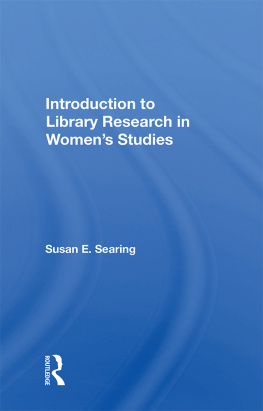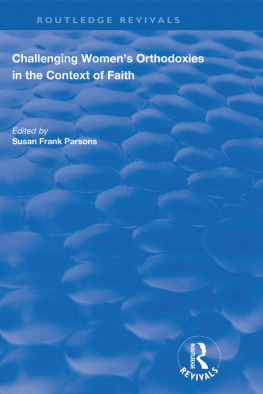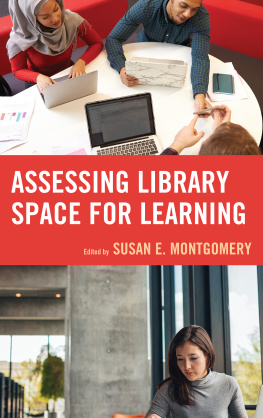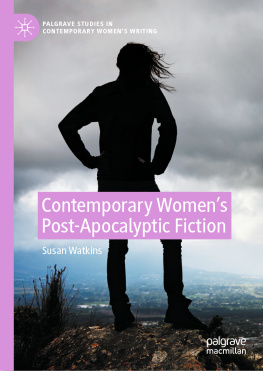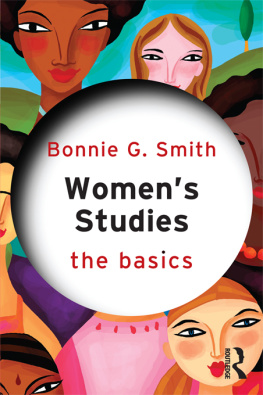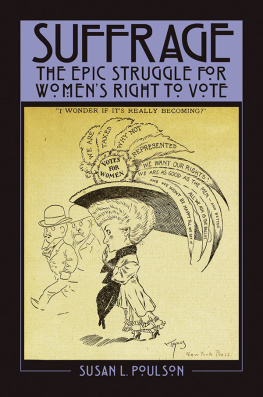Introduction to Library Research in Women's Studies
Other Titles in This Series
Doing Library Research, Robert K. Baker
Introduction to Library Research in French Literature, Robert K. Baker
Aging and the Aged: An Annotated Bibliography and Library Research Guide, Linna F. Place, Linda Parker, and Forrest J. Berghorn
Introduction to Library Research in German Studies: Language, Literature, and Civilization, Larry L. Richardson
Introduction to Library Research in Hispanic Literature, Szilvia E. Szmuk and Angela B. Dellepiane
Also of Interest
*The Underside of History: A View of Women Through Time, Elise Boulding
International Law and the Status of Women, Natalie Kaufman Hevener
Comparable Worth: The Myth and the Movement, Elaine Johansen
*Women in Third World Development, Sue Ellen M. Charlton
*The Hidden Sun: Women of Modern Japan, Dorothy Robins-Mowry
Women in the Cities of Asia: Migration and Urban Adaptation, edited by James T. Fawcett, Siew-Ean Khoo, and Peter C. Smith
Women and Revolution in Iran, edited by Guity Nashat
Social Power and Influence of Women, edited by Liesa Stamm and Carol D. Ryff
Working Women: A Study of Women in Paid Jobs, edited by Ann Seidman
Covert discrimination and Women in the Sciences, edited by Judith A. Ramaley
Computerised Literature Searching : Research Strategies and Databases, Charles L. Gilreath
*Available in hardcover and paperback
Westview Guides to Library Research
Robert K. Baker, Series Editor
Introduction to Library Research in Women's Studies
Susan E. Searing
This book fills the need for an introduction to research tools and library services valuable in the investigation of topics related to women. The core of the book is an annotated bibliography that describes selected bibliographies, indexes, catalogs, handbooks, directories, and biographical dictionaries and evaluates the traditional reference aids available in most college libraries in terms of their usefulness in women's studies research. Organized by type of material and general topic, the bibliography is fully indexed by author, title, and specific subject.
Ms. Searing addresses the general principles of library organization and highlights issues and problems of central concern to researchers in women's studies, such as sexism in card catalog subject headings. The book illustrates the planning and conduct of systematic literature searches to aid both student and scholar in diving into the interdisciplinary waters of women's studies.
Susan E. Searing is Women's Studies Librarian-at-Large for the University of Wisconsin System.
Introduction to Library Research in Women's Studies
Susan E. Searing
First published 1985 by Westview Press
Published 2018 by Routledge
52 Vanderbilt Avenue, New York, NY 10017
2 Park Square, Milton Park, Abingdon, Oxon OX14 4RN
Routledge is an imprint of the Taylor & Francis Group, an informa business
Copyright 1985 by Susan E. Searing
All rights reserved. No part of this book may be reprinted or reproduced or utilised in any form or by any electronic, mechanical, or other means, now known or hereafter invented, including photocopying and recording, or in any information storage or retrieval system, without permission in writing from the publishers.
Notice:
Product or corporate names may be trademarks or registered trademarks, and are used only for identification and explanation without intent to infringe.
Library of Congress Cataloging in Publication Data
Searing, Susan E.
Introductin to library research in women's studies.
Includes index.
1. Reference books--Women--Bibliography. 2. Women-
Bibliography. 3. Women--Research--Methodology.
4. Women's studies--Bibliography. I. Title.
Z7961.S42 1985 [HQ1206] 016.3054 85-3162
ISBN 13: 978-0-367-01898-6 (hbk)
This book grew out of my preparations to teach a seminar at Yale in 1981. Titled "Interdisciplinary Research: Women's Studies," the junior-level course was funded by the National Endowment for the Humanities under a curriculum development grant to the fledgling Women's Studies Program.
In designing the syllabus, I faced a major problem the lack of a text. The only published research guide in women's studies was out-of-print, and in any case it failed to reflect the latest scholarship and newest tools. More up-to-date bibliographies of bibliographies served only as partial remedies, since they focused on a single type of reference source and did not provide guidance in library research planning or technique. I did what so many women's studies teachers have been forced to do: I pieced together a reading list of articles and chapters in books and placed the materials on reserve. And I substituted hands-on research exercises for classroom discussions.
I later realized that a guide to library research could serve not only as a text for women's studies students, but also as a desk manual for faculty and librarians engaged both in their own projects and in directing student research. My goal, therefore, is to extend two kinds of help to researchers: first, by guiding students in choosing topics and formulating search strategies for term paper assignments; and second, by recommending reference tools that can yield up information about women in a number of disciplines.
present the basic facts some underlying premises of women's studies as field of inquiry, how libraries are organized, and how researchers can proceed most effectively. I emphasize the challenges involved in seeking information on gender-related subjects, guide the reader in constructing an individualized research plan, and provide guidelines for evaluating the relevance of reference tools to one's inquiry.
focus on multidisciplinary access tools for particular forms of publication: books; periodical articles; newspapers; government documents; conference proceedings; and dissertations.
Chapters 9.1 through 9.17 look at bibliographic resources in various disciplines and fields of study. Each chapter opens with a short introduction to subject headings used in the library catalog and a list of basic research guides, for readers unacquainted with the discipline being treated.
discuss additional types of resources -- published library catalogs, biographical sources, directories, microforms, online data bases, periodicals, and handbooks. The appendices provide outlines of the Dewey Decimal and Library of Congress classifications and a full list of review articles in the leading women's studies journal, Signs.
Throughout the book I have provided possible call numbers for the works I cite, insofar as I could determine them from standard cataloging records. Most references include one or two Library of Congress call numbers and a Dewey Decimal number. Readers are cautioned to recheck the numbers in their local catalog if they cannot locate the items under the numbers suggested here.
This guide is selective and by no means covers the full breadth of the reference literature available on women. New sources are constantly being published, and I will be only too happy to learn of better tools that supercede those recommended within these pages.
Although faculty, graduate students, librarians, and independent researchers may all find useful information and encouragement here, undergraduate students are the intended audience. Almost all of the reference tools described are in the English language. Although I enforced no chronological limits, most of the cited sources have been published within the last ten years.


